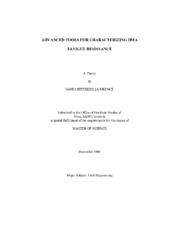| dc.contributor.advisor | Epps Martin, Amy | |
| dc.creator | Lawrence, James Jefferies | |
| dc.date.accessioned | 2011-02-22T22:23:41Z | |
| dc.date.accessioned | 2011-02-22T23:45:02Z | |
| dc.date.available | 2011-02-22T22:23:41Z | |
| dc.date.available | 2011-02-22T23:45:02Z | |
| dc.date.created | 2009-12 | |
| dc.date.issued | 2011-02-22 | |
| dc.date.submitted | December 2009 | |
| dc.identifier.uri | https://hdl.handle.net/1969.1/ETD-TAMU-2009-12-7320 | |
| dc.description.abstract | Accurately and efficiently characterizing the material properties of hot mix
asphalt (HMA) is critical to the design and development of pavements that can
experience repeated loading for long periods of time and resist fatigue cracking. The
Calibrated Mechanistic with Surface Energy (CMSE) method of design to preclude this
primary type of distress requires that the HMA material be tested using the Relaxation
Modulus (RM) and Repeated Direct Tension (RDT) tests to determine the material
properties required for accurate calculations.
The RM test requires considerable time to complete and provides results with
relatively high variability. Further research has lead to the development of the
Viscoelastic Characterization (VEC) test, from which the RM master curve can be
developed. Material properties from the RM master curve can be easily determined and
applied in the CMSE method.
The modified repeated direct tension (RDT*) test removes rest periods and
unwanted healing from the RDT test. The RDT* test also allows the dissipated pseudo
strain energy (DPSE) to be separated into permanent deformation and fatigue cracking energies. The rate of change in DPSE associated with fatigue can then be applied in the
CMSE method.
Data sets for these tests are extensive and time consuming to analyze. Microsoft
Excel spreadsheet macros were developed to reduce the time required for analysis from
an estimated 10 hours to approximately 8 minutes.
Testing of 14 different samples showed that the VEC and RDT* tests still
required some adjustments in order to get accurate results. The rate of loading in the
VEC test must be reduced to allow sufficient testing time to obtain the required data.
The RDT* test requires a decrease in the controlling strain levels from 80 mu-epsilon and 350 mu-epsilon
to 20 mu-epsilon and 175 mu-epsilon for the undamaged and damaged portions of the test, respectively.
Testing of a sample using the new VEC and RDT* test recommendations showed
that the recommended changes provided better results. Samples were undamaged where
required and damaged portions of the test ran to completion without causing
compression or sample failure. Material properties can be accurately determined and
applied in the CMSE method. | en |
| dc.format.mimetype | application/pdf | |
| dc.language.iso | en_US | |
| dc.subject | Asphalt Fatigue Testing | en |
| dc.subject | Asphalt Fatigue | en |
| dc.subject | Viscoelastic Characterization | en |
| dc.subject | Repeated Direct Tension | en |
| dc.subject | Calibrated Mechanistic with Surface Energy | en |
| dc.title | Advanced Tools For Characterizing HMA Fatigue Resistance | en |
| dc.type | Thesis | en |
| thesis.degree.department | Civil Engineering | en |
| thesis.degree.discipline | Civil Engineering | en |
| thesis.degree.grantor | Texas A&M University | en |
| thesis.degree.name | Master of Science | en |
| thesis.degree.level | Masters | en |
| dc.contributor.committeeMember | Lytton, Robert L. | |
| dc.contributor.committeeMember | Glover, Charles J. | |
| dc.type.genre | thesis | en |
| dc.type.material | text | en |


